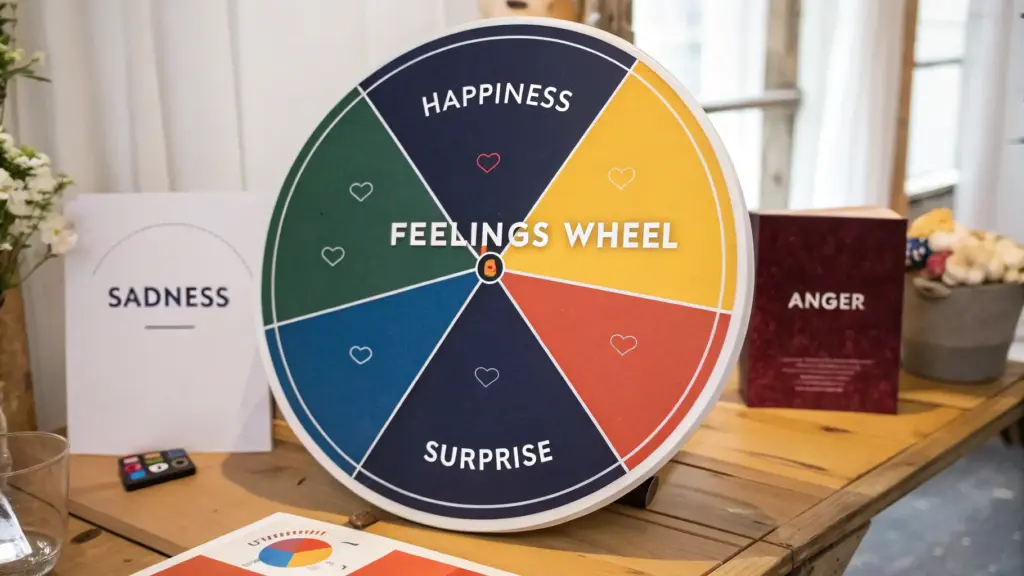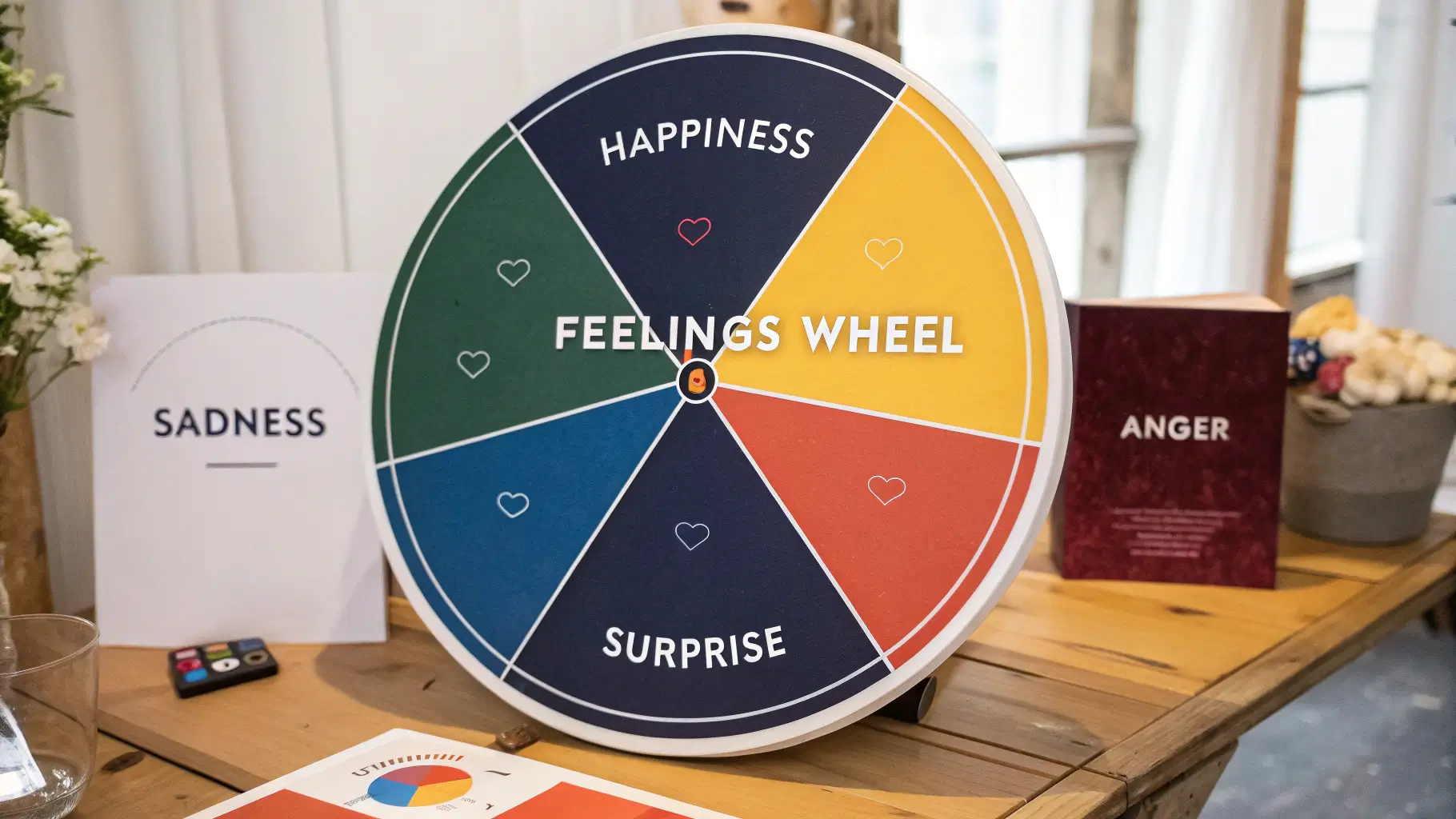
Unlocking Emotional Intelligence: A Comprehensive Guide to the Feelings Wheel
In today’s fast-paced world, understanding and managing our emotions is more crucial than ever. Emotional intelligence, the ability to perceive, use, understand, manage, and handle emotions, plays a pivotal role in our personal and professional lives. One powerful tool that aids in developing emotional intelligence is the Feelings Wheel. This article provides a comprehensive guide to the Feelings Wheel, exploring its origins, structure, benefits, and practical applications.
What is the Feelings Wheel?
The Feelings Wheel, also known as the emotion wheel, is a visual tool designed to help individuals identify and articulate their emotions more accurately. It typically consists of concentric circles, with basic emotions at the center and more nuanced feelings radiating outwards. This structure allows users to start with a broad emotion and then delve deeper into the specific feeling they are experiencing.
Origins of the Feelings Wheel
While various iterations of emotion wheels exist, one of the most recognized versions was developed by Dr. Gloria Willcox in the 1980s. Her original wheel was designed to help individuals expand their emotional vocabulary and improve their ability to communicate their feelings effectively. Later, Dr. Robert Plutchik developed his own “Wheel of Emotions” which focused on eight basic emotions and their various combinations. Both wheels have contributed significantly to the field of psychology and emotional literacy.
Structure of the Feelings Wheel
Understanding the structure of the Feelings Wheel is key to utilizing it effectively. Most wheels are organized into several layers:
- Core Emotions: These are the fundamental emotions, such as happiness, sadness, anger, fear, surprise, and disgust. They form the innermost circle of the wheel.
- Secondary Emotions: Moving outwards, you’ll find secondary emotions that are variations or combinations of the core emotions. For example, anger might branch out into frustration, irritation, or rage.
- Tertiary Emotions: The outermost layer contains even more specific and nuanced feelings. These are often complex emotions that require a deeper level of self-awareness to identify.
The color-coding of different emotions can also be a helpful visual aid, allowing users to quickly identify related feelings.
Benefits of Using the Feelings Wheel
The Feelings Wheel offers numerous benefits for individuals seeking to enhance their emotional intelligence and overall well-being:
- Improved Emotional Awareness: By providing a visual map of emotions, the wheel helps individuals become more aware of the wide range of feelings they experience.
- Enhanced Communication: The wheel expands emotional vocabulary, enabling individuals to articulate their feelings more accurately and effectively to others.
- Better Emotional Regulation: Understanding and labeling emotions is the first step towards managing them. The wheel facilitates this process, allowing individuals to respond to their emotions in a healthier way.
- Increased Empathy: Recognizing and understanding one’s own emotions can foster greater empathy for others. The wheel can be used to explore the feelings of others, promoting more compassionate interactions.
- Reduced Stress and Anxiety: By identifying and addressing underlying emotions, the wheel can help reduce stress and anxiety levels. It provides a framework for processing difficult feelings and developing coping strategies.
How to Use the Feelings Wheel
Using the Feelings Wheel is a straightforward process that can be incorporated into daily routines or used as a tool for specific emotional challenges:
- Identify the Initial Feeling: Start by identifying the core emotion you are experiencing. For example, you might feel generally “sad.”
- Explore the Secondary Emotions: Move outwards to the next layer of the wheel and explore the secondary emotions related to sadness. You might find that you are feeling “disappointed,” “lonely,” or “grief-stricken.”
- Pinpoint the Specific Feeling: Continue moving outwards to the tertiary emotions to pinpoint the most specific feeling. For example, you might realize that you are feeling “heartbroken” or “melancholy.”
- Reflect on the Feeling: Once you have identified the specific feeling, take time to reflect on it. Consider what triggered the feeling, how it is affecting you, and what you can do to address it.
- Communicate the Feeling: If appropriate, communicate your feeling to others. This can help you build stronger relationships and receive support.
Practical Applications of the Feelings Wheel
The Feelings Wheel can be applied in various settings, including:
- Therapy: Therapists often use the wheel to help clients explore and process their emotions in a safe and structured environment.
- Counseling: Counselors can use the wheel to assist individuals in identifying the root causes of their emotional distress.
- Education: Educators can incorporate the wheel into social-emotional learning programs to teach students about emotions and how to manage them.
- Personal Development: Individuals can use the wheel as a self-help tool to enhance their emotional intelligence and improve their overall well-being.
- Workplace: The Feelings Wheel can be used in the workplace to improve communication, resolve conflicts, and foster a more emotionally intelligent work environment. [See also: Building Emotional Resilience in the Workplace]
The Feelings Wheel and Emotional Regulation
Emotional regulation is the ability to manage and control one’s emotional responses. The Feelings Wheel plays a crucial role in this process by providing a framework for understanding and labeling emotions. When individuals can accurately identify their feelings, they are better equipped to regulate them effectively.
By using the wheel, individuals can learn to:
- Recognize Early Warning Signs: Identify the physical and emotional cues that signal an impending emotional reaction.
- Challenge Negative Thoughts: Question the validity of negative thoughts and beliefs that contribute to emotional distress.
- Develop Coping Strategies: Implement healthy coping strategies, such as deep breathing, mindfulness, or exercise, to manage difficult emotions.
- Seek Support: Reach out to trusted friends, family members, or professionals for support when needed.
Limitations of the Feelings Wheel
While the Feelings Wheel is a valuable tool, it’s essential to acknowledge its limitations:
- Oversimplification: The wheel may oversimplify the complexity of human emotions. Some feelings may not fit neatly into the categories provided.
- Cultural Bias: Some emotions may be more prevalent or expressed differently in certain cultures. The wheel may not be universally applicable.
- Subjectivity: The interpretation of emotions is subjective and can vary from person to person. The wheel should be used as a guide, not a definitive source of truth.
Alternatives to the Feelings Wheel
While the Feelings Wheel is a popular tool, several alternatives can also be used to explore and understand emotions:
- Emotion Cards: These cards feature different emotions and can be used to spark conversations and promote emotional awareness.
- Journaling: Writing about one’s feelings can be a powerful way to process emotions and gain insights.
- Mindfulness Meditation: Practicing mindfulness can help individuals become more aware of their emotions in the present moment.
- Therapy: Working with a therapist can provide a safe and supportive environment to explore complex emotions. [See also: The Benefits of Cognitive Behavioral Therapy]
The Future of Emotional Intelligence and the Feelings Wheel
As the importance of emotional intelligence continues to grow, the Feelings Wheel is likely to remain a valuable tool for individuals and organizations alike. Future developments may include:
- Digital Versions: Interactive digital versions of the wheel that offer personalized insights and recommendations.
- Integration with AI: Integration with artificial intelligence to provide real-time emotional feedback and support.
- Customized Wheels: Customized wheels that cater to specific populations, such as children, adolescents, or individuals with mental health conditions.
Conclusion
The Feelings Wheel is a powerful tool for unlocking emotional intelligence and improving overall well-being. By providing a visual map of emotions, the wheel helps individuals become more aware of their feelings, communicate them more effectively, and regulate them in a healthier way. Whether used in therapy, education, or personal development, the Feelings Wheel can empower individuals to navigate the complexities of human emotions with greater confidence and compassion. Embracing the Feelings Wheel can lead to a richer, more fulfilling life, characterized by stronger relationships, greater self-awareness, and enhanced emotional resilience. The ability to understand and articulate your feelings is a cornerstone of emotional intelligence, and the Feelings Wheel provides a practical and accessible pathway to achieving this vital skill. So, take a moment to explore the Feelings Wheel and unlock the power of your emotions.

